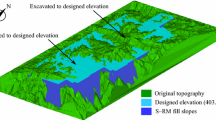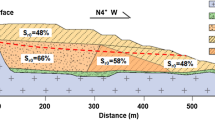Abstract
Internal erosion caused by seepage at the soil–rock interface with local coarse particle enrichment zones (CPEZ) is a significant factor contributing to geological disasters during rainfall events. The mechanism of landslides induced by internal erosion at the soil–rock interface within CPEZ with high permeability remains unclear. This study incorporated a degradation model of bonding strength and a viscous force model into the discrete-element software MatDEM to analyze the evolution of seepage erosion at the soil–rock interface. The numerical simulations investigated the impact of the number and spacing distance of CPEZ on erosion characteristics within the interface seepage. Subsequently, the study analyzed the infiltration process and stability of the Gendakan slope during heavy rainfall to understand the failure mechanism of rainfall-induced landslides with local CPEZ at the soil–rock interface. The findings suggest that the seepage erosion process can be divided into three stages: initial, development transition, and destruction stages. Moreover, the overall permeability of the numerical model strengthens with the increase in CPEZ scale and permeability difference. A higher number of CPEZ distributed throughout the sample increases susceptibility to seepage erosion, while wider spacing between CPEZ reduces their impact on overall permeability. The numerical analysis of the Gendakan landslide highlights the importance of instability at the foot of the slope due to internal erosion of CPEZ in triggering traction landslides across the accumulation mass. This paper delves into the failure mechanism of seepage erosion at the soil–rock interface, offering theoretical support for the prevention and control of landslide geological disasters.




















Similar content being viewed by others
Data Availability
The raw/processed data required to reproduce these findings cannot be shared at this time as they are also part of ongoing research.
References
Brinkman HC (1949) A calculation of the viscous force exerted by a flowing fluid on a dense swarm of particles. Laboratory N V De Bataafsche Petroleum Maatschappij, Amsterdam, Netherlandshttps://doi.org/10.1007/bf02120313
Dawson EM, Roth WH, Drescher A (1999) Slope stability analysis by strength reduction. Géotechnique 49:835–840. https://doi.org/10.1680/geot.1999.49.6.835
Deng ZZ, Wang G, ** W et al (2023) Characteristics and quantification of fine particle loss in internally unstable sandy gravels induced by seepage flow. School of Civil Engineering, Chongqing University, Chongqing 400045, China; Key Laboratory of New Technology for Construction of Cities in Mountain Area, Chongqing 400045, China; Chengdu Engineering Corporation Limited, Power China, Ch 321:107150. https://doi.org/10.1016/j.enggeo.2023.107150
Griffiths DV, Lane PA (1999) Slope stability analysis by finite elements. Géotechnique 49:387–403. https://doi.org/10.1680/geot.1999.49.3.387
Gu DM, Huang D, Liu HL et al (2019) A DEM-based approach for modeling the evolution process of seepage-induced erosion in clayey sand. State Key Laboratory of Ocean Engineering, School of Naval Architecture, Ocean, and Civil Engineering, Shanghai Jiao Tong University Shanghai Key Laboratory for Digital Maintenance of Buildings and Infrastructure, Department of Civil En 14:1629–1641. https://doi.org/10.1007/s11440-019-00848-0
Huang D, Huang WB, Ke CY et al (2021) Experimental investigation on seepage erosion of the soil–rock interface. Zi** School of Geology and Mining, Fuzhou University, 350108, Fuzhou, Fujian, China; Fujian Key Laboratory of Geohazard Prevention, 350002, Fuzhou, Fujian, China; College of Civil Engineering, Fuzhou Un 80:3115–3137https://doi.org/10.1007/s10064-021-02104-w
Ke CY (2021) Study on the penetration and erosion failure rules and evolution mechanism of sandy clay-rock interface. Hebei University of Technology (in Chinese)
Kim HJ, Park JM, Shin JH (2019) Flow behaviour and pi** potential at the soil–structure interface. Géotechnique 69:79–84. https://doi.org/10.1680/jgeot.17.T.020
Li JJ, Wang WH, Ran MY (2022a) Threshold analysis of landslide geological hazards induced by precipitation in hilly areas—taking Enyang District, Bazhong City as an example. Guizhou Provincial Climate Center; School of Atmospheric Science, Nan**g University; National Climate Center 42:279–284
Li T, He B, Chen Z, Zhang Y, Liang C, Wang R (2016) Effects of gravel on infiltration, runoff, and sediment yield in landslide deposit slope in Wenchuan earthquake area, China. College of Resources and Environment, Southwest University, Beibei District Chongqing 400715 China School of Geography, Bei**g Normal University, Bei**g 100875 China College of Water Resource and Hydropower 23:12075–12084. https://doi.org/10.1007/s11356-016-6394-x
Li Y, Meng H, Dong Y et al (2004) Types and characteristics of geological disasters in China—analysis based on the results of geological disaster survey in counties and cities across the country. China University of Geosciences (Bei**g); China Institute of Geological Environment Monitoring; China Institute of Geological Environment Monitoring 15:29–34
Li YJ, Chen NS, YY et al (2022b) Characteristics and causes of the “8·21” post-rain landslide in Zhonghai Village, Hanyuan County. School of Public Safety and Emergency Management, Kunming University of Science and Technology; Chengdu Institute of Mountain Hazards and Environment, Ministry of Water Re 49:185–195
Liu C, Pollard DD, Deng S et al (2015a) Mechanism of formation of wiggly compaction bands in porous sandstone: 1. Observations and conceptual model. [1] State Key Laboratory for Mineral Deposits Research, School of Earth Sciences and Engineering, Nan**g University, Nan**g, China [2] Department of Geological and Environmental Sciences, Stanford University, S 120:8138–8152. https://doi.org/10.1002/2015jb012372
Liu C, Pollard DD, Gu K et al (2015b) Mechanism of formation of wiggly compaction bands in porous sandstone: 2. Numerical simulation using discrete element method. School of Earth Sciences and Engineering, Nan**g University, 22 Hankou Rd, Nan**g 210093, China; Department of Geological and Environmental Sciences, Stanford University, Stanford, CA, United States 120:8153–8168
Liu C, Pollard DD, Gu K, Shi B (2015) Mechanism of formation of Wiggly compaction bands in porous sandstone: 2. Numerical simulation using discrete element method. J Geophys Res Solid Earth 120(12):8153–8168. https://doi.org/10.1002/2015JB012374
Marinho FAM Jr (2020) Effect of suction on the shear strength of soil-rock interfaces. Geotech Geol Eng 38:6145–6155. https://doi.org/10.1007/s10706-020-01421-3
Matsui B, **n JJ (1992) Finite element slope stability analysis by shear strength reduction technique. Department of Civil Engineering, Osaka University Research Associate, Department of Civil Engineering, Osaka University 32:59–70. https://doi.org/10.3208/sandf1972.32.59
Senthilkumar V, Chandrasekaran SS, Maji VB (2018) Rainfall-induced landslides: case study of the Marappalam landslide, Nilgiris District, Tamil Nadu, India. SCALE Vellore Institute of Technology, Dept of Structural and Geotechnical Engineering, Tamil Nadu, Vellore, 632014, India; Indian Institute of Technology Madras, Dept of Civil Engineering, Tamil Nadu, Chennai, 60 18:05018006. https://doi.org/10.1061/(asce)gm.1943-5622.0001218
Tu G, Huang D, Huang R, Deng H (2019) Effect of locally accumulated crushed stone soil on the infiltration of intense rainfall: a case study on the reactivation of an old deep landslide deposit (Article). Zi** School of Geology and Mining, Fuzhou University, 350108, Fuzhou, Fujian, China; Fujian Key Laboratory of Geohazard Prevention, 350002, Fuzhou, Fujian, China; College of Civil Engineering, Fuzhou Un 78:4833–4849. https://doi.org/10.1007/s10064-019-01460-y
Wang JJ, **ao LL, Zhang J et al (2020) Deformation characteristics and failure mechanisms of a rainfall-induced complex landslide in Wanzhou County, Three Gorges Reservoir, China. School of Highway, Chang'an University, 710064, **'an, China School of Geological Engineering and Geomatics, Chang'an University, 710064, **'an, China Tunnel and Underground Engineering Research Center of Jiangsu Province, 210041, Nan**g, Ch 17:419–431https://doi.org/10.1007/s10346-019-01317-1
Wang WP, Yang XQ, Zhang ZQ et al (2017) Climatic characteristics and trend changes in the number of rainy days in China. Guizhou Provincial Climate Center; School of Atmospheric Science, Nan**g University; National Climate Center 37:317–328. https://doi.org/10.3969/2017jms.0010
Wang XW, Xu YS (2023) Permeability property variation in sandy soil induced by suffusion via a horizontal seepage laboratory test. State Key Laboratory of Ocean Engineering, School of Naval Architecture, Ocean, and Civil Engineering, Shanghai Jiao Tong University Shanghai Key Laboratory for Digital Maintenance of Buildings and Infrastructure, Department of Civil En 1–14. https://doi.org/10.1007/s11440-023-01890-9
Wang Y, Liu C, Liu XL et al (2021) Discrete element numerical simulation of seabed pore pressure accumulation process under wave action. School Earth Sci Eng Nan**g Univ School Environ Sci Eng Ocean Univ China 43:88–95
**ong H, Zhang ZM, Sun XH et al (2022) Clogging effect of fines in seepage erosion by using CFD–DEM. Key Laboratory of Coastal Urban Resilient Infrastructures (MOE), Shenzhen University, Shenzhen 518060, Guangdong, China College of Civil and Transportation Engineering, Shenzhen University, Shenzhen 518060, Guangdong, China Shenz, vol 152. https://doi.org/10.1016/j.compgeo.2022.105013
Yin YZ, Cui YF, Liu DZ et al (2019) Study on the microscopic process of fine particle migration in loose soil. Key Laboratory of Mountain Hazards and Surface Processes, Chinese Academy of Sciences; Chengdu Institute of Mountain Hazards and Environment, Ministry of Water Resources, Chinese Academy of Sciences; Univer 51:21–29. https://doi.org/10.15961/j.jsuese.201900253
Zhang J, Kuang MX, Zhang YH et al (2021) Evaluation and analysis of the causes of a landslide and treatment measures during the excavation of a tunnel through a soil-rock interface. Key Laboratory of Ministry of Education for Geomechanics and Embankment Engineering, Hohai University, No1 **kang Road, Nan**g 210024, China China Railway (Shanghai) Investment Group Co LTD, Shanghai 200135, China 130:105784. https://doi.org/10.1016/j.engfailanal.2021.105784
Zhou K, Wang H, Liao JX et al (2023) Deformation and failure mechanism of colluvial landslide under sustained rainfall-a case study of **nzhan landslide in Tongzi County, China. Guizhou Transportation Planning Survey & Design Academe COLTD, Guiyang, Guizhou 550081, China; College of Civil Engineering, Guizhou University, Guiyang, Guizhou 550025, China; Meteorological Bureau of Tongzi County, Zunyi 71:89–103. https://doi.org/10.1016/j.aej.2023.03.044
Zienkiewicz OC, Humpheson C, Lewis RW (1975) Associated and non-associated visco-plasticity and plasticity in soil mechanics. Geotechnique 25:671–689. https://doi.org/10.1680/geot.1975.25.4.671
Acknowledgements
The research was supported by the National Natural Science Foundation of China (nos. 41902290, 42272331) and by Natural Science Foundation of Hebei Province (no. D2020202002).
Author information
Authors and Affiliations
Contributions
LH completed the data collection work and completed most of the numerical simulation experiments and obtained the results; SYX guided the entire process of completing the paper and participated in the numerical simulation experiments; LTY completed the abstract, introduction, conclusion and revised the article format.GDM prepared figures5. HD prepared figures1. All authors reviewed the manuscript.
Corresponding author
Ethics declarations
Competing interests
The authors declare no competing interests.
Additional information
Publisher's Note
Springer Nature remains neutral with regard to jurisdictional claims in published maps and institutional affiliations.
Rights and permissions
Springer Nature or its licensor (e.g. a society or other partner) holds exclusive rights to this article under a publishing agreement with the author(s) or other rightsholder(s); author self-archiving of the accepted manuscript version of this article is solely governed by the terms of such publishing agreement and applicable law.
About this article
Cite this article
Song, Y., Lv, T., Liu, H. et al. Failure mechanism of the slope containing coarse particle enrichment zones located at the soil–rock interface under the heavy rainfall. Environ Earth Sci 83, 302 (2024). https://doi.org/10.1007/s12665-024-11590-6
Received:
Accepted:
Published:
DOI: https://doi.org/10.1007/s12665-024-11590-6




